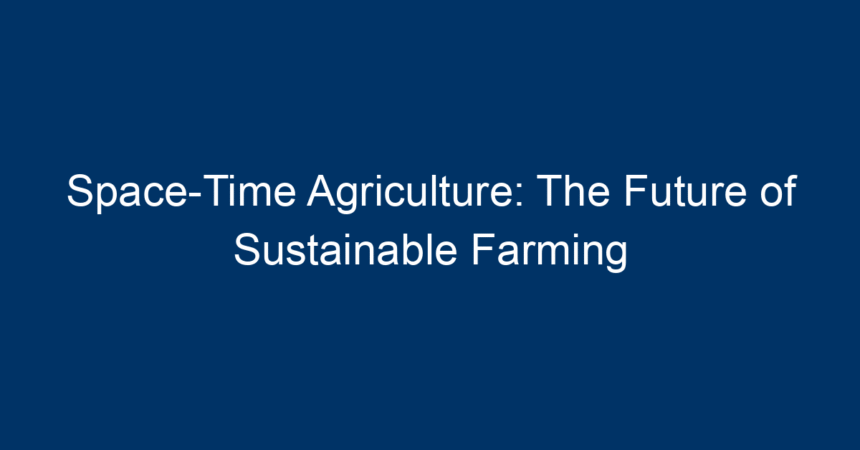Introduction
Imagine a world where farming is not limited by the constraints of land and time, where crops yield abundantly with minimal environmental impact. This vision is becoming a reality through a revolutionary approach known as space-time agriculture. This innovative methodology harmonizes technology, ecology, and advanced farming techniques to create sustainable food systems. As we delve deeper into this transformative concept, it’s crucial to understand how space-time agriculture can reshape our future and address pressing challenges such as food security and climate change.
Understanding Space-Time Agriculture
What is Space-Time Agriculture?
At its core, space-time agriculture refers to an integrated farming approach that utilizes data-driven technologies and sustainable practices to optimize crop production and resource use. This innovative strategy leverages various techniques, including vertical farming, hydroponics, and precision agriculture, to maximize outputs while minimizing environmental footprints.
The Importance of Sustainability in Agriculture
The agricultural sector is a significant contributor to greenhouse gas emissions and environmental degradation. Traditional farming practices often lead to soil depletion, water scarcity, and loss of biodiversity. Sustainable farming, including space-time agriculture, aims to mitigate these issues by adopting practices that promote resource conservation and ecological balance.
The Components of Space-Time Agriculture
1. Vertical Farming
Vertical farming is a game-changer in the realm of space-time agriculture. By stacking crop production vertically, this technique minimizes land use and optimizes space—ideal for urban environments. With controlled environments that regulate temperature, humidity, and light, vertical farms can yield crops year-round, independent of weather conditions.
2. Precision Agriculture
Precision agriculture employs data analytics and IoT technologies to monitor and manage crop health in real-time. Sensors collect data on soil moisture, nutrient levels, and pest activity, enabling farmers to make informed decisions. This data-driven approach enhances efficiency, reduces chemical usage, and promotes sustainable practices.
3. Hydroponics and Aquaponics
Both hydroponics and aquaponics are integral to space-time agriculture. Hydroponics involves growing plants without soil, using nutrient-rich water solutions. Aquaponics takes it a step further by integrating fish cultivation, allowing symbiotic relationships between plants and fish to thrive. These methods use significantly less water than traditional farming, contributing to sustainable agriculture.
4. Agroecology and Permaculture
Agroecology applies ecological principles to agricultural practices, fostering symbiotic relationships among different farming elements. Permaculture emphasizes designing agricultural systems that are sustainable and mimetic of natural ecosystems. Both practices align perfectly with space-time agriculture, promoting biodiversity and resource efficiency.
The Technological Backbone of Space-Time Agriculture
1. Artificial Intelligence and Machine Learning
Artificial Intelligence (AI) revolutionizes space-time agriculture by enhancing decision-making processes. Machine learning algorithms analyze vast amounts of data, predicting crop yields, and optimizing resource allocation. AI can identify potential pest outbreaks, weather changes, and crop diseases before they impact production, thus safeguarding food supplies.
2. Drones and Robotics
Drones equipped with advanced imaging technologies enable farmers to conduct aerial surveys of their crops. This allows for the identification of unhealthy plants and pest infestations early on, enabling targeted interventions. Robotics further automate tasks such as planting, harvesting, and even weeding, increasing efficiency and reducing labor costs.
3. Blockchain Technology
Blockchain technology ensures traceability and transparency in the food supply chain. By implementing blockchain, farmers can better manage their resources, track the origin of their produce, and ensure ethical and sustainable practices throughout the supply chain. This enhances consumer trust and promotes the adoption of sustainable agriculture practices.
Benefits of Space-Time Agriculture
1. Enhanced Crop Yields
Utilizing space-time agriculture techniques can significantly increase crop yields. With the ability to grow crops year-round and the optimization of inputs through precision agriculture, farmers can produce more food in a smaller area. This is critical in addressing global food insecurity.
2. Resource Conservation
Space-time agriculture prioritizes resource conservation. Techniques such as hydroponics use up to 90% less water than traditional farming. Moreover, precision agriculture allows for decreased use of fertilizers and pesticides, reducing the environmental impact of farming.
3. Climate Resilience
As climate change intensifies, traditional farming methods become more vulnerable to extreme weather patterns. Space-time agriculture offers resilience by utilizing controlled environments and climate-smart practices, ensuring food production remains stable irrespective of environmental conditions.
4. Local Food Production
Localizing food production through space-time agriculture reduces transportation costs and emissions. Urban vertical farms can supply fresh produce to nearby communities, shortening the farm-to-table cycle. This not only enhances freshness but also supports local economies.
Challenges and Solutions in Implementing Space-Time Agriculture
1. Initial Costs and Investment
The transition to space-time agriculture often requires significant initial investment in technology and infrastructure. However, government incentives, grants, and partnerships can mitigate these costs.
2. Knowledge and Skill Gaps
To effectively implement space-time agriculture, farmers need access to training and resources. Educational programs and workshops can help equip farmers with the necessary skills to adopt these technologies.
3. Public Awareness and Acceptance
Consumer acceptance of food produced through innovative methods like hydroponics and vertical farming can be a challenge. Increasing public awareness about the benefits of space-time agriculture can foster acceptance and interest in sustainable practices.
Actionable Insights for the Future
1. Invest in Education
Farmers, agriculturalists, and governments must invest in education and training programs that focus on the principles and practices of space-time agriculture.
2. Foster Collaboration
Collaboration between tech companies, agricultural experts, and policymakers is vital. By working together, stakeholders can develop innovative solutions that enhance the efficacy of space-time agriculture.
3. Promote Research and Development
Advocating for research in sustainable farming practices will pave the way for advancements in space-time agriculture, ensuring ongoing innovation and relevance.
4. Encourage Local Initiatives
Local communities can bolster their food systems by supporting urban farming projects and local produce markets. This not only supports sustainable practices but also strengthens local economies.
Conclusion
Space-time agriculture represents a paradigm shift in the way we approach farming. By combining innovative technologies with sustainable practices, we can create a resilient food system capable of meeting the demands of a growing population. As we navigate the challenges of food security and environmental sustainability, embracing space-time agriculture is not just beneficial—it’s essential for a thriving future. Every individual, from policymakers to consumers, has a role to play in nurturing this transformative movement. By supporting sustainable practices, engaging in local food initiatives, and promoting education around space-time agriculture, we can cultivate a greener, more prosperous world for generations to come.




